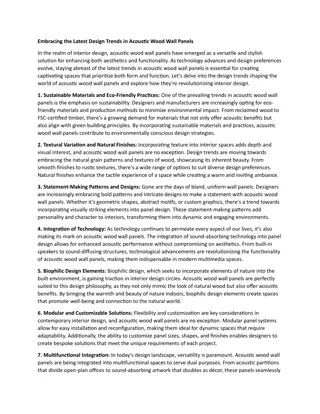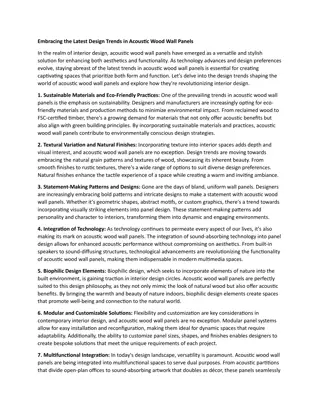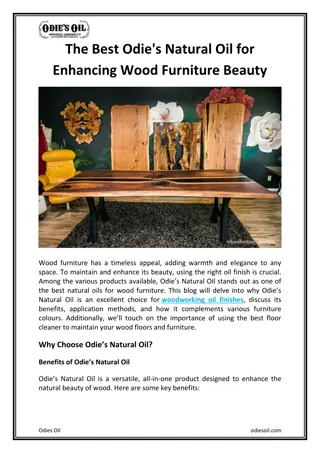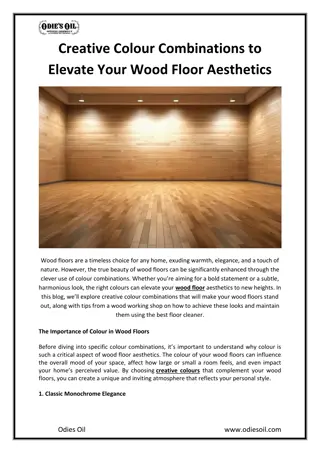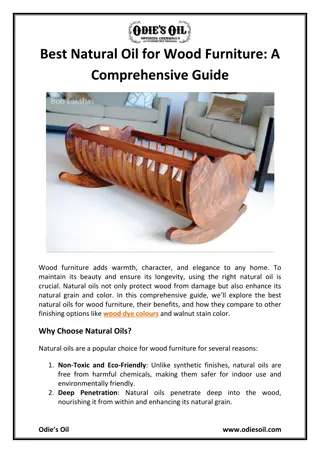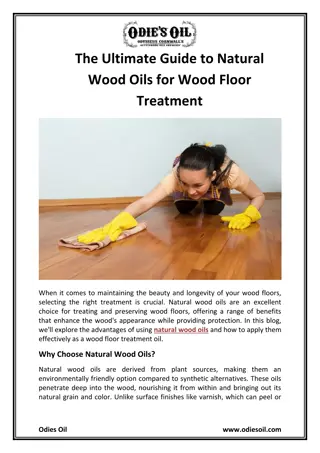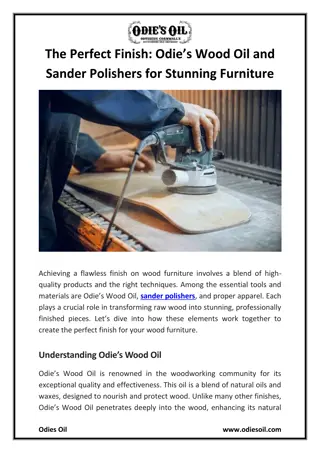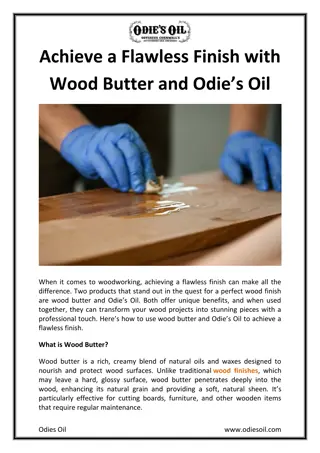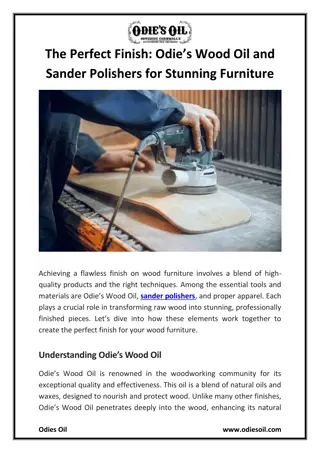
Guide to Wood Finishes: Types, Application, and Benefits
Explore the world of wood finishes, learn why applying a finish is crucial, discover the preparation steps, types of finishes available, delve into varnish specifics, and understand the application of varnish, stains, and dyes for a professional touch on your woodworking projects.
Download Presentation

Please find below an Image/Link to download the presentation.
The content on the website is provided AS IS for your information and personal use only. It may not be sold, licensed, or shared on other websites without obtaining consent from the author. If you encounter any issues during the download, it is possible that the publisher has removed the file from their server.
You are allowed to download the files provided on this website for personal or commercial use, subject to the condition that they are used lawfully. All files are the property of their respective owners.
The content on the website is provided AS IS for your information and personal use only. It may not be sold, licensed, or shared on other websites without obtaining consent from the author.
E N D
Presentation Transcript
WHY APPLY A FINISH? There are two main reasons for applying a finish to wood: 1.To protect the wood 2.To enhance the appearance
PREPARING FOR A FINISH 1.Use a smoothing plane to remove pencil marks and blemishes. 2.Use a coarse or medium grade of glass paper to smooth the surfaces. 3.Rub a damp paper towel over the surfaces of the wood. This raises the grain.
PREPARING FOR A FINISH 4. Use a fine grade glass paper to remove the fibres which have been raised. 5. Apply first coat of chosen finish and allow to dry. 6. Sand again with fine grade glass paper. 7. Apply second coat and allow to dry.
TYPES OF FINISH Coloured Finishes Clear Finishes Varnish Vegetable Oil Danish Oil Teak Oil Wax Polish Shellac Paint Stain Dye Coloured wax polish Clear finishes are used when you want the natural grain of the wood to show through.
VARNISH Varnish is supplied as water based or oil based. The water based varnish is an environmentally friendly version of the oil based varnish. Some varnishes are for interior woodwork and others for exterior (some types can be used for both). Probably the best known varnishes are Polyurethane Varnish and Yacht Varnish. These give a quality, protective finish and they can be thinned with thinners, white spirits or turpentine substitute, if a thin coat is required or if it is to be sprayed rather than brushed. Varnish is UV resistant, protects the surface of the wood and helps prevent cracking and shrinking of the wood. It is available as a matt, silk or gloss finish. When using water based varnish, brushes can be cleaned with warm soapy water. When using the oil based varnish, white spirit, thinners or turpentine substitute is used to clean equipment.
APPLYING VARNISH Applying Varnish with a brush A good finish can be achieved with a quality paint brush. Do not apply too much varnish, be sparing and spread the varnish as a thin coat. More than one coat will be needed. Allow plenty of time between coats. After applying the first coat, allow to dry and then gently sand the surface with fine abrasive or wire wool. Then apply the next coat.
STAINS AND DYES Whilst varnish and paint puts a layer on the surface of the wood, dye and stains soak into the surface fibres. The most common stains tend to be water or solvent based. When applied, they need a further finish such as varnish or wax, in order to protect the surface and to give a matt, silk of gloss finish. Water based dyes are more environmentally friendly, but when applied tend to raise the grain of the wood, giving a rough feel. A little smoothing with fine abrasive paper may be needed before a further finish is applied. Solvent based dyes, dry quickly and have the advantage that they do not raise the grain, unlike water based dyes. Dyes and stains are supplied in a range of vibrant colours or wood based tones. They can be applied with a paint brush, a soft cloth or even a paint pad (if covering a large area). The preferred method is using a soft cloth and gloves should be worn to prevent staining the skin.
WAX AND POLISH Wax can be applied to wood products, that are for interior use only. It is usually supplied as a liquid or paste and is transparent or coloured. The liquid polish is useful when covering large areas, because it can be applied with a brush. The paste wax is applied with a soft cloth and requires several coats. It is good practice to apply a coat of wax periodically, which helps to refresh the finish. The best quality furniture wax contains bees wax, which has been softened by the addition of turpentine, making it possible to easily apply / spread on a surface.
WAX AND POLISH Ensure the surface is prepared by sanding with a range of abrasive, coarse to fine. A first coat of wax is quickly rubbed into the surface, in a circular fashion. Almost straightaway, use a clean cloth to go over the surface, removing surplus wax. Leave the wax to dry over night and then apply another coat, in the direction of the grain. When dry, polish the surface with another soft cloth. A number of layers can be applied, depending on the surface finish achieved by previous layers.
SHELLAC Shellac is a non-toxic, natural finish, produced from processed resin, that is secreted from the forest inhabiting insect, Laccifer Lacca, found from India to the Far East. The processed resin, which are in the form of light brown flakes, are mixed with alcohol, producing a liquid. Shellac is the basic ingredient of a range of polishes. Shellac based polishes, produce a high quality finish, typical of vintage furniture, but they do not withstand water or heat very well. Shellac must be applied quite quickly, avoiding any drips. It can be applied with a quality brush or a soft pad. The first coat is followed by sanding with fine abrasive or steel wool. A second coat can then be applied. It is important to work relatively quickly as shellac is fast drying.
OIL Oil is a popular finish for woods and can be applied using a brush or a cloth, spreading very easily across the surface. There is a selection of oils, including teak oil for external garden furniture and danish oil for interior furniture and woodwork. Oils tend to slightly darken wood, especially lighter woods such as pine, giving a rich finish. Oil can be applied to bare wood and previously dyed wood, but not material that has been varnished or waxed. With previously dyed wood, test a small area first. When dealing with wood that already has a finish, the surface has to be carefully prepared. Varnish can be sanded away and a wax finish can be removed with white spirit. Danish oil is a mixture of thinned oil and varnish. The oil is usually tung oil, also called Chinese oil (oil ground from nuts found in Asia and South America). The oil penetrates the wood fibres, whilst the varnish leaves a layer on the surface, offering some protection against spills, knocks and scratches. It gives a natural glaze to wood and is a good choice for kitchen worktops or surfaces being used for food preparation, as it is a safe choice. Danish oil is water resistant and consequently can be used on external woodwork and furniture.
OIL When applying oil, ensure that the surface has been prepared. Then, apply with a cloth or brush in the direction of the grain, removing excess oil. For a silky look, sand the surface (fine abrasive or wire wool) after the first coat of oil. A slightly abrasive pad, can also be used between coats. New wood should be oiled three times, leaving a number of hours between each coat. It is worth noting, that danish oil can be thinned with white spirit, which allows the oil to absorb further into the surface. Wood finished with danish oil, is ready for use after about 48 hours.
PAINT Paint is essentially the same as varnish, although it contains coloured pigments. Paints are applied with a brush or spray gun and add a protective layer to the surface. Paints are available as matt, silk and gloss finishes and they are either water based or oil (solvent) based. Unlike many other finishes that enhance the natural grain of the wood, paints hide the grain. Paint primer is required to seal the wood, so that there is a stable base for the application of the next paint, which is undercoat. Undercoat is supplied in a restricted range of colours and is selected according to the colour of the final top coat. The undercoat blocks all blemishes, grain and marks, providing a blank canvas for the top coat. The top coat provides the final finish, in terms of the colour and whether it is matt, silk or gloss.
PAINT Paints are categorised is being water or oil (solvent) based. Water based paints are much more environmentally friendly. They dry more rapidly and do not produce the amount of odour associated with solvent based paints. After use, brushes and equipment can be cleaned in soapy water. These paints are supplied in a wide range of colours and shades. Solvent based paints are more damaging to the environment and the health of humans. Brushes and equipment have to be cleaned with thinners or white spirit, which is also damaging to the environment. When these paints are drying the solvents evaporate, releasing volatile organic compounds (VOCs) into the atmosphere. However, these paints generally give a superior finish, that lasts much longer than the water based paints, especially if painting is outside.
SPRAY PAINT Spray paints can be bought straight off the shelf of most hardware stores. The preparation of the surface to be sprayed, is the same as any surface requiring a finish. In addition, a primer and an undercoat may still be required. The advantage of this system, is that the spray can be used straightway. Spray cans are often used to spray large areas relatively quickly. If used carefully, they deliver a high quality finish. They are a very convenient delivery system for paint. One disadvantage, is that the cans are disposable, but they are difficult to recycle. They contain a compressed gas (liquefied petroleum gas) that acts as the propellent for the paint. The gas is not environmentally friendly, but much better than the CFC (chlorofluorocarbon) gases, that were used until the 1980s. These were widely blamed for serious damage to the earth s protective ozone layer. The cans also contain ball bearings, that when shaken, mix the paint before it s application. All this makes it difficult to recycle used cans.


